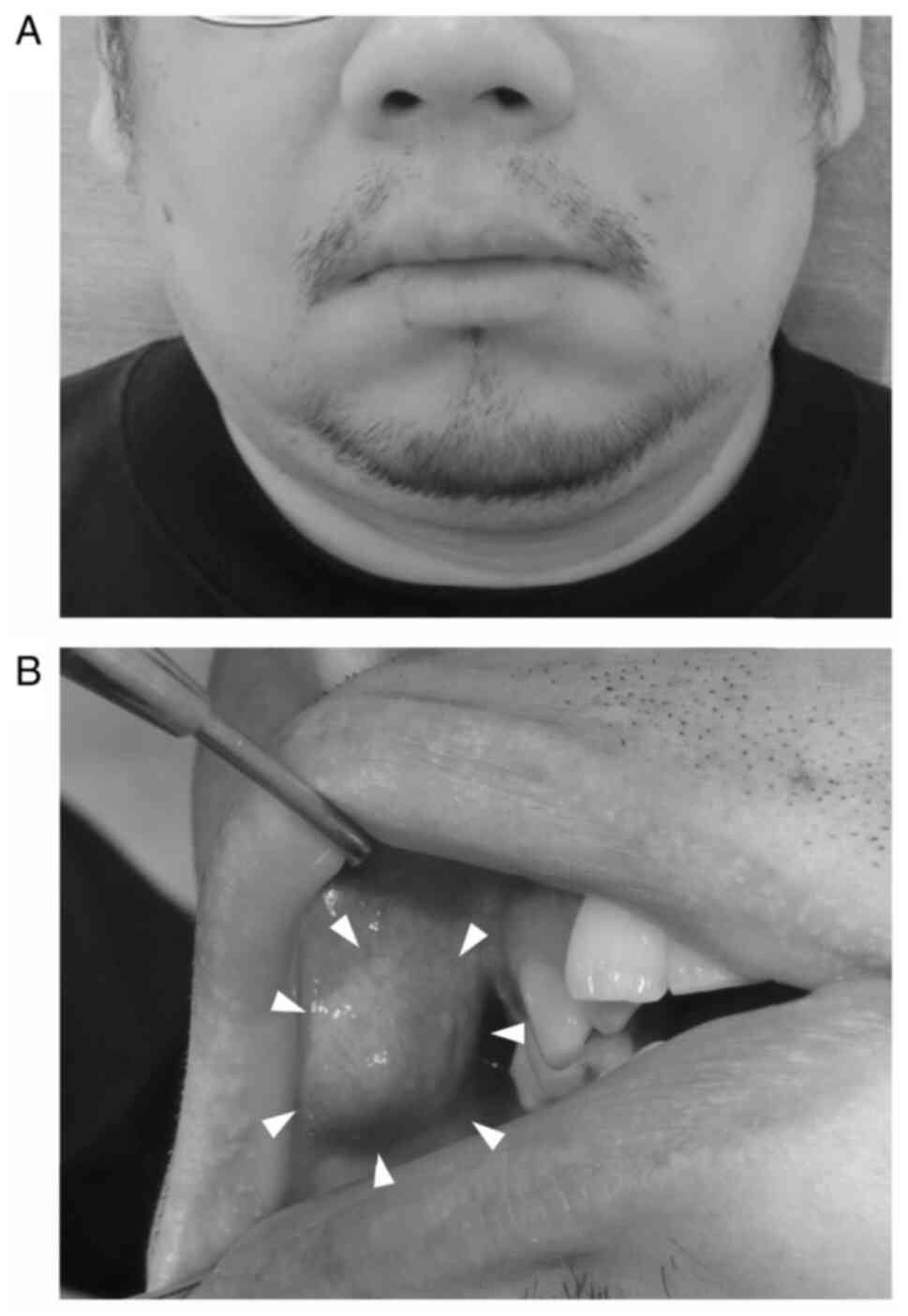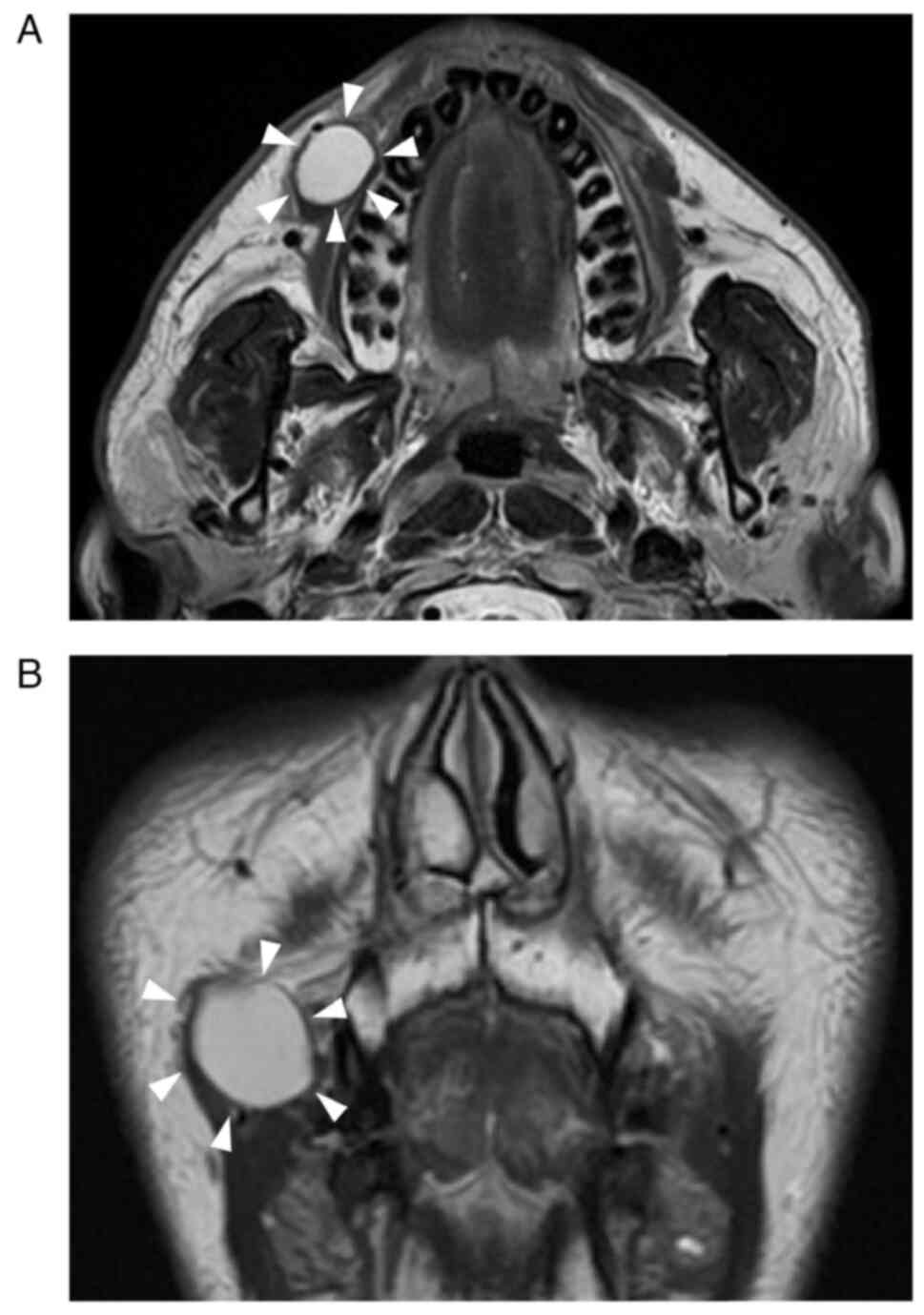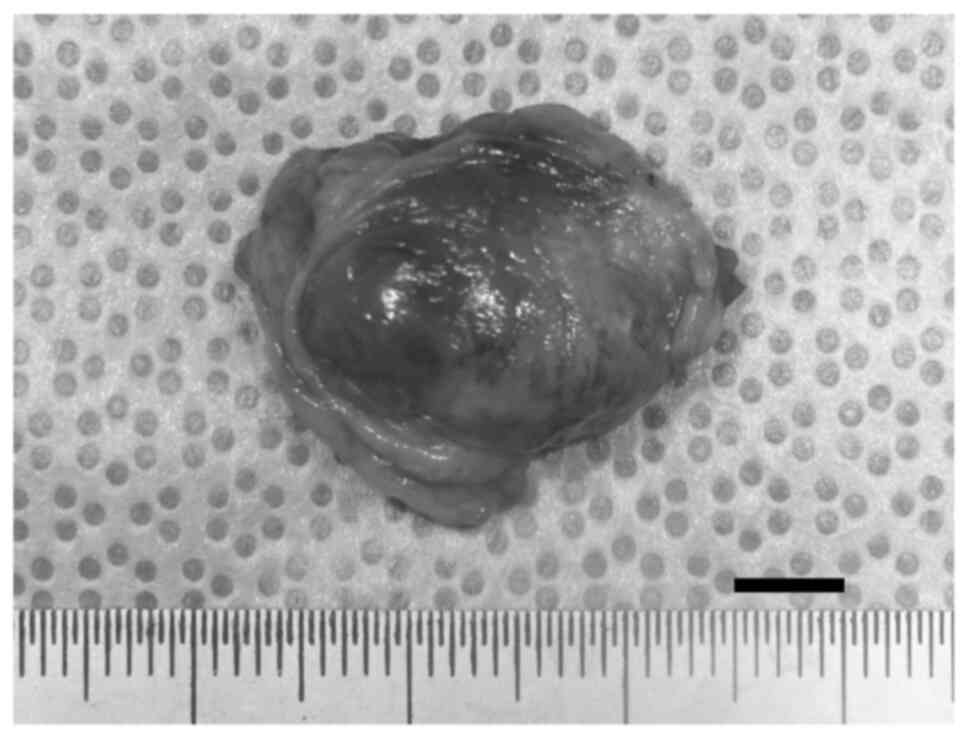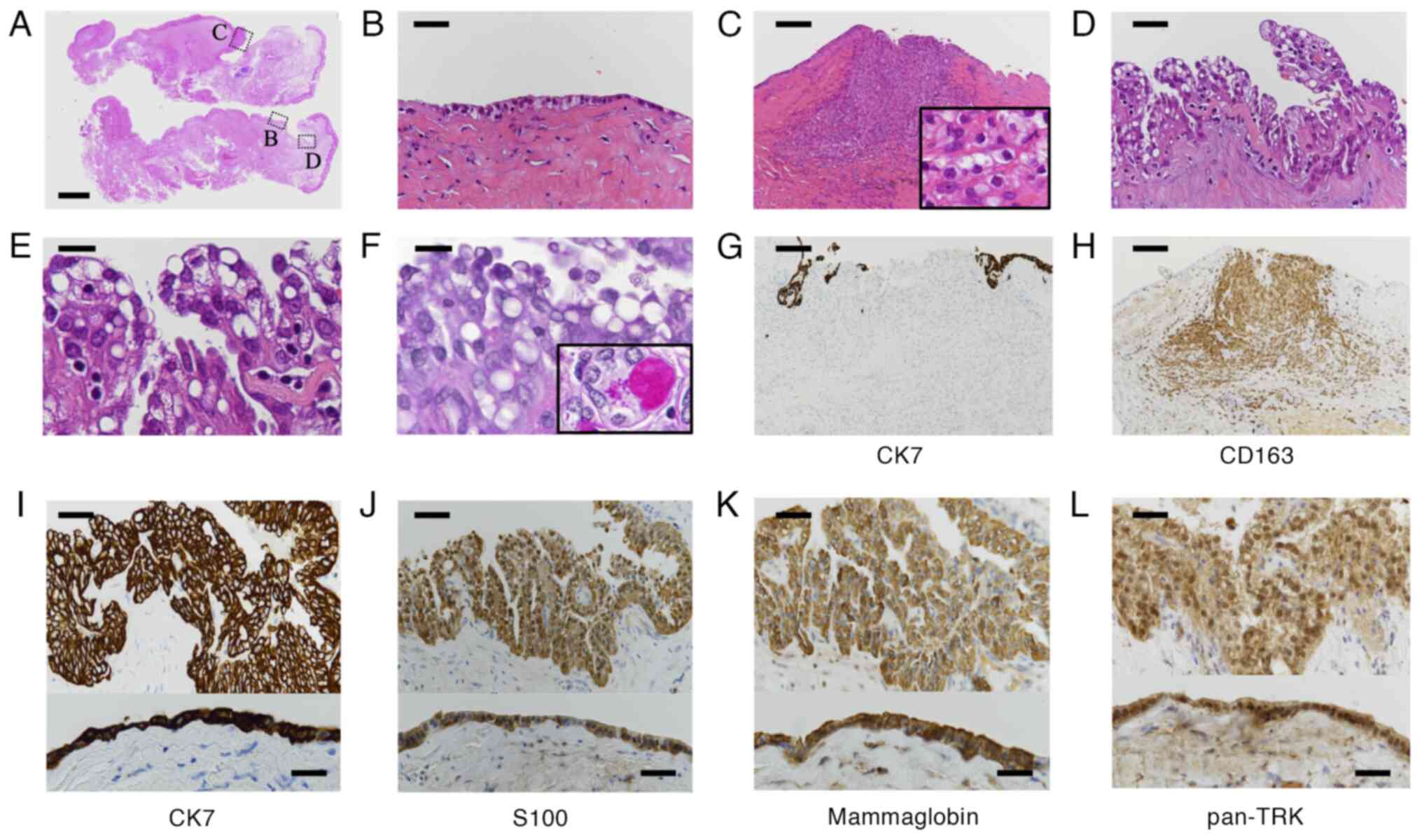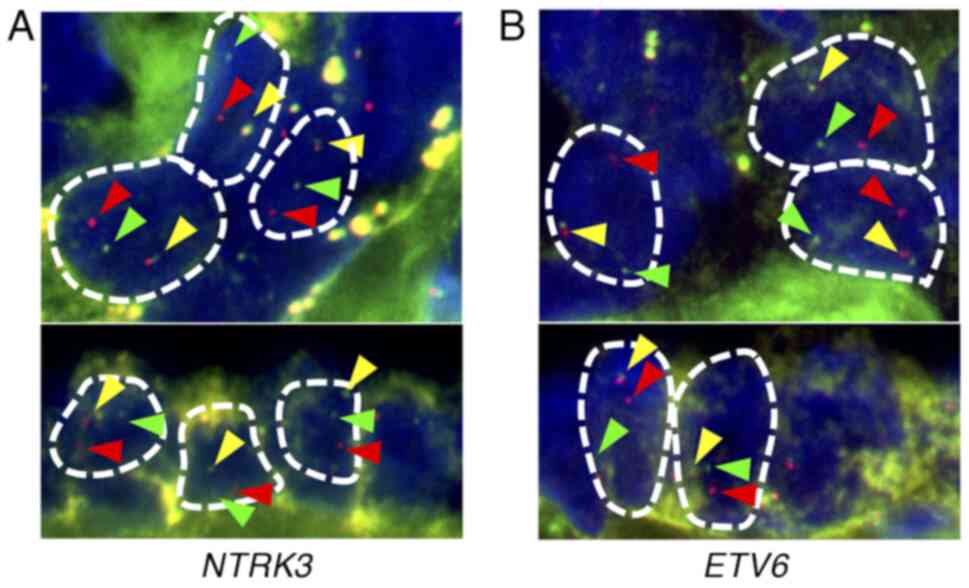Macrocystic secretory carcinoma arising from the buccal minor salivary gland clinically mimicking a mucocele: A case report
- Authors:
- Published online on: August 12, 2024 https://doi.org/10.3892/ol.2024.14626
- Article Number: 493
-
Copyright: © Chida et al. This is an open access article distributed under the terms of Creative Commons Attribution License.
Abstract
Introduction
In 2010, salivary gland carcinoma, a histological type of salivary gland carcinoma with a morphology similar to secretory carcinoma of the mammary gland, was reported as mammary analogue secretory carcinoma (MASC) (1). In 2017, the WHO Classification of Head and Neck Tumors (4th edition) classified MASC as a secretory carcinoma (SC), establishing it as a new histologic type of salivary gland cancer (2). The histological types of salivary gland carcinoma are diverse and often difficult to diagnose. Before the disease classification was established as SC, it was most likely classified as acinic cell carcinoma or cystadenocarcinoma (3). In addition, for the diagnosis of SC, it is crucial to identify the ETV6-NTRK3 fusion gene (EN gene) by molecular biological search in addition to immunohistochemical stains such as S100 and mammaglobin (1).
SC accounts for only 5% of all salivary gland malignancies, and the parotid gland is the predilection site. It is most common in people in their 40s, with a male-to-female ratio of 1.4:1 (4). SC presents as a painless, slow-growing mass (2), and the main treatment is surgical resection. SC is considered a low-grade malignant tumor because the prognosis of SC is generally good, with a 10-year survival rate of 95% and a disease-free survival rate of 89%, although isolated cases of cervical lymph node metastasis and distant metastasis have been reported (4).
To the best of our knowledge, there have been no previous reports of SCs with complete cystic lesions originating from minor salivary glands of the buccal mucosa. Herein, we report a case of SC of minor salivary gland origin in the buccal mucosa, which was suspected to be a mucocele on preoperative imaging examination.
Case report
A 46-year-old man visited the Department of Oral and Maxillofacial Surgery at Saiseikai Senri Hospital in October 2022 with a chief complaint of swelling of the right buccal mucosa. He had been aware of the swelling for approximately 18 months. However, he left it untreated because it was painless. As the swelling gradually increased in size, he opted to visit the Department of Oral and Maxillofacial Surgery at Saiseikai Senri Hospital. The patient's current medical history included hypertension and cerebral infarction, and his only medication was an antihypertensive drug. He was 169.5 cm tall and weighed 86.7 kg, with a Body Mass Index of 30.2. On physical examination, there was no obvious facial swelling or perceptual abnormalities (Fig. 1A). Intraoral examinations revealed a submucosal lesion of approximately 20 mm in diameter located anteriorly inferior to the parotid papilla in the right buccal mucosa (Fig. 1B). The lesion was dark blue, elastic hard, painless, submucosally mobile, and did not fade under pressure. Magnetic Resonance (MR) T2-weighted imaging showed a high-signal area with a clear boundary and uniform interior, approximately 18 mm in diameter, within the right buccal mucosa (Fig. 2). Based on our findings, the clinical diagnosis of a mucocele of minor salivary gland origin in the right buccal mucosa was made. However, given the size of the lesion and the length of time since the onset of subjective symptoms, we considered the possibility that it was a malignancy tumor. Therefore, although we did not perform fine needle aspiration cytology (FNAC) before surgery, the lesion, including a portion of the surrounding tissue, was resected under general anesthesia in the month after his initial consultation (Fig. 3).
The resected lesion was grossly cyst-like, with yellowish-brown serous fluid. Hematoxylin-and-eosin (H&E) staining revealed a cystic lesion covered with epithelium (Fig. 4A). The surface of the cystic lesion was predominantly lined with a single cuboidal or cylindrical epithelium layer (Fig. 4B). In some areas, clusters of cells with a pale, foamy cytoplasm invading the fibrous wall were observed (Fig. 4C). Additionally, in some areas, hobnail or papillary growth was evident (Fig. 4D). The cytoplasm was pale, foamy, and vacuolated. Nuclear atypia was not prominent (Fig. 4E). Periodic acid Schiff (PAS) staining revealed that the epithelial cells were negative for both cytoplasmic mucin and cytoplasmic zymogen granules, which are morphological characteristics of mucoepidermoid carcinomas and acinic cell carcinomas, respectively (Fig. 4F). Immunohistochemical analysis using cytokeratin 7 (CK7) and macrophage marker CD163 was performed to rule out the invasive nature of the lesion; clusters of cells invading the fibrous wall were CK7-negative (Fig. 4G) and CD163-positive indicating that the foamy cells were mucophages (Fig. 4H). These histological analyses suggested that the cystic lesion was non-invasive, and differential diagnosis included both benign neoplastic lesions and malignant lesions, such as cystadenoma, intraductal carcinoma, and SC. Immunohistochemical staining showed that the epithelial cells were positive for CK7 (Fig. 4I), S100 (Fig. 4J), and mammaglobin (Fig. 4K), and negative for p63 and DOG1 (not shown). Thereafter, we indirectly confirmed the presence of the ETV6-NTRK3 fusion using NTRK3 break-apart fluorescence in situ hybridization (FISH) (Fig. 5A), ETV6 break-apart FISH (Fig. 5B), and pan-TRK immunohistochemistry (Fig. 4L). Thus, the patient was diagnosed with SC. The surgical margins were negative.
Contrast-enhanced CT and FDG-PET/CT performed after the diagnosis of SC showed no cervical lymph node metastasis or distant metastasis (Fig. S1). Ultimately, the patient was diagnosed with stage I secretory cancer (pT1N0M0). Because more than 1 month had passed before the diagnosis was confirmed, the margins of the resected lesion were negative, and the wound was completely epithelialized, no additional resection was performed. One year and 4 months postoperatively, no local recurrence, cervical lymph node metastasis, distant metastasis has been observed.
Discussion
Cystic salivary gland diseases that occur in the buccal submucosa and other minor salivary gland areas include mucoceles; ductal, epidermoid, dermoid, and lymphoepithelial cysts; cystadenoma; cystic polymorphous adenoma; and intraductal, low-grade mucoepidermoid, and acinic cell carcinomas (5–8). In this case, because MRI T2-weighted imaging performed in the preoperative examination showed a high-signal image with clear boundaries and a homogeneous interior, and the lesion was painless and mobile, a non-neoplastic mucocele was suspected and excision was performed. Subsequently, H&E staining ruled out non-neoplastic lesions, and immunostaining results led to strongly suspected SC. Break-apart FISH analysis confirmed the presence of the EN gene. Furthermore, the cystic epithelium was positive for pan-TRK staining, which supported the presence of the NTRK gene, and this case was diagnosed as SC (Figs. 4 and 5) (9–12). Differentiating SC from acinic cell carcinoma is sometimes difficult, and it is important to confirm the presence of Zymogen granules by immunostaining for DOG1 and PAS staining if needed (13).
SC may present with a mucocele-like appearance on MRI, and FNAC is considered when salivary gland cystic disease is suspected. One of the limitations of this study is that we did not perform FNAC, which would have been useful for preoperative diagnosis (14). In total, four cases of SC with suspected cystic disease on preoperative imaging examination have been reported in the past (Table I) (15–18). Of the two patients who underwent preoperative FNAC, the EN gene was detected in one case, and the diagnosis of SC was made. In contrast, the other patient was not diagnosed with malignant lesions. The other two patients who did not undergo FNAC had preoperatively suspected cystic lesions or benign tumors. Therefore, performing FNAC does not guarantee preoperatively diagnosis of SC. The preoperative diagnosis of salivary gland malignancies is very difficult to make because of the infrequency of salivary gland malignancies themselves, the rarity of SC, and the frequent absence of pain symptoms that characterize many malignancies. For this reason, the possibility of malignancy must always be considered when salivary gland disease is suspected. FNAC for salivary gland disease has a sensitivity of 89–100% and specificity of 85–92% (19), and some reports indicate that FNAC for salivary gland cystic disease in particular is more accurate than for all salivary gland lesions (14).
While there have been reports of the macrocystic form of SC in major salivary glands, there have been no reports thereof in minor salivary glands of the buccal mucosa, as in the present case. The reports of macrocystic SC in major salivary glands showed that tumor cells lining the lumen of the cyst may be reduced or not infiltrate the surrounding area, thus making it difficult to distinguish them from mucoceles or ductal cysts on histopathologic H&E staining; immunohistochemical findings targeting S-100 and mammaglobin and molecular biological searches targeting the EN gene are therefore important for diagnosis (13). Our case demonstrated the presence of the macrocystic form of SC in minor salivary glands. Both major and minor salivary glands may show mucocele-like images on MR imaging and it is therefore important to always include clinical and histopathological investigations for malignancy in cystic lesions in the minor salivary glands, without excluding the possibility of neoplastic lesions. The patient currently has no signs of recurrence and metastasis, and the prognosis is considered good. However, further studies are needed to accumulate more cases.
In conclusion, in this report, we described a case of SC, of minor salivary gland origin, in the buccal mucosa and reviewed related literature. The unique characteristics and treatment considerations highlighted in this case contribute valuable insights to the field of oral oncology.
Supplementary Material
Supporting Data
Acknowledgements
The authors would like to thank Dr Motomu Tsuji (Department of Pathology, Saiseikai Senri Hospital, Suita-shi, Japan) for assisting with the diagnosis.
Funding
Funding: No funding was received.
Availability of data and materials
The data generated in the present study may be requested from the corresponding author.
Authors' contributions
The manuscript was produced and reviewed by all authors collectively. TC and YM confirm the authenticity of all the raw data. TC, ATN, YU, TK, KW, SK, YM and NU designed the study. TC, ATN, YU, KW, SK, YM and NU wrote the manuscript. TC, KW and TK were involved in patient care. YU and KH were the pathologists in charge of the case. All authors agreed to be held accountable for all aspects of the work. All authors read and approved the final manuscript.
Ethics approval and consent to participate
Not applicable.
Patient consent for publication
The patient has been informed that there is no risk to their anonymity in association with the publication of this report. Written informed consent was obtained from the patient for the publication of the present case report.
Competing interests
The authors declare that they have no competing interests.
Glossary
Abbreviations
Abbreviations:
|
CK7 |
cytokeratin 7 |
|
FISH |
fluorescence in situ hybridization |
|
FNAC |
fine needle aspiration cytology |
|
MASC |
mammary analogue secretory carcinoma |
|
PAS |
periodic acid Schiff |
|
SC |
secretory carcinoma |
References
|
Skálová A, Vanecek T, Sima R, Laco J, Weinreb I, Perez-Ordonez B, Starek I, Geierova M, Simpson RHW, Passador-Santos F, et al: Mammary analogue secretory carcinoma of salivary glands, containing the ETV6-NTRK3 fusion gene: A hitherto undescribed salivary gland tumor entity. Am J Surg Pathol. 34:599–608. 2010. View Article : Google Scholar : PubMed/NCBI | |
|
El-Naggar AK, Chan JKC, Grandis JR, Takata T and Slootweg PJ: World Health Organization Classification of Head and Neck Tumours. 4th edition. IARC Press; Lyon: 2017 | |
|
Chiosea SI, Griffith C, Assaad A and Seethala RR: Clinicopathological characterization of mammary analogue secretory carcinoma of salivary glands. Histopathology. 61:387–394. 2012. View Article : Google Scholar : PubMed/NCBI | |
|
Alves LDB, de Melo AC, Farinha TA, de Lima Araujo LH, Thiago LS, Dias FL, Antunes HS, Amaral Eisenberg AL, Santos Thuler LC and Cohen Goldemberg D: A systematic review of secretory carcinoma of the salivary gland: where are we? Oral Surg Oral Med Oral Pathol Oral Radiol. 132:e143–e152. 2021. View Article : Google Scholar : PubMed/NCBI | |
|
Takita H, Takeshita T, Shimono T, Tanaka H, Iguchi H, Hashimoto S, Kuwae Y, Ohsawa M and Miki Y: Cystic lesions of the parotid gland: Radiologic-pathologic correlation according to the latest World Health Organization 2017 classification of head and neck tumours. Jpn J Radiol. 35:629–647. 2017. View Article : Google Scholar : PubMed/NCBI | |
|
Layfield LJ and Gopez EV: Cystic lesions of the salivary glands: Cytologic features in fine-needle aspiration biopsies. Diagn Cytopathol. 27:197–204. 2002. View Article : Google Scholar : PubMed/NCBI | |
|
Pinto A, Nosé V, Rojas C, Fan YS and Gomez-Fernandez C: Searching for mammary analogue [corrected] secretory carcinoma of salivary gland among its mimics. Mod Pathol. 27:30–37. 2014. View Article : Google Scholar : PubMed/NCBI | |
|
Hoang VT, Trinh CT, Nguyen CH, Chansomphou V, Chansomphou V and Tran TTT: Overview of epidermoid cyst. Eur J Radiol Open. 6:291–301. 2019. View Article : Google Scholar : PubMed/NCBI | |
|
Michal M, Hrabal P and Skálová A: Oncocytic cystadenoma of the parotid gland with prominent signet-ring cell features. Pathol Int. 48:629–633. 1998. View Article : Google Scholar : PubMed/NCBI | |
|
Weber A, Langhanki L, Schütz A, Gerstner A, Bootz F, Wittekind C and Tannapfel A: Expression profiles of p53, p63, and p73 in benign salivary gland tumors. Virchows Arch. 441:428–436. 2002. View Article : Google Scholar : PubMed/NCBI | |
|
Di Palma S: Carcinoma ex pleomorphic adenoma, with particular emphasis on early lesions. Head Neck Pathol. 7 (Suppl 1):S68–S76. 2013. View Article : Google Scholar : PubMed/NCBI | |
|
Hung YP, Fletcher CDM and Hornick JL: Evaluation of pan-TRK immunohistochemistry in infantile fibrosarcoma, lipofibromatosis-like neural tumour and histological mimics. Histopathology. 73:634–644. 2018. View Article : Google Scholar : PubMed/NCBI | |
|
Hernandez-Prera JC, Holmes BJ, Valentino A, Harshan M, Bacchi CE, Petersson F, Liu KK, Najfeld V and Wenig BM: Macrocystic (mammary analogue) secretory carcinoma: An unusual variant and a pitfall in the differential diagnosis of cystic lesions in the head and neck. Am J Surg Pathol. 43:1483–1492. 2019. View Article : Google Scholar : PubMed/NCBI | |
|
Maleki Z, Allison DB, Butcher M, Kawamoto S, Eisele DW and Pantanowitz L: Application of the Milan system for reporting salivary gland cytopathology to cystic salivary gland lesions. Cancer Cytopathol. 129:214–225. 2021. View Article : Google Scholar : PubMed/NCBI | |
|
Gupta K, Patwa HS, Niehaus AG, Filho GOF and Lack CM: Mammary analogue secretory carcinoma presenting as a cystic parotid mass. Radiol Case Rep. 14:1103–1108. 2019. View Article : Google Scholar : PubMed/NCBI | |
|
Helmy D, Chang J, Bishop JW, Vong A, Raslan O and Ozturk A: MR imaging findings of a rare pediatric parotid tumor: Mammary analogue secretory carcinoma. Radiol Case Rep. 15:1460–1463. 2020. View Article : Google Scholar : PubMed/NCBI | |
|
Black M, Liu CZ, Onozato M, Iafrate AJ, Darvishian F, Jour G and Cotzia P: Concurrent identification of novel EGFR-SEPT14 fusion and ETV6-RET fusion in secretory carcinoma of the salivary gland. Head Neck Pathol. 14:817–821. 2020. View Article : Google Scholar : PubMed/NCBI | |
|
Shibata E, Morita KI, Kayamori K, Maruiwa M, Michi Y, Sato Y, Takeuchi K, Ikeda T, Harada H and Yoda T: Secretory carcinoma around Stensen's duct misdiagnosed as salivary duct cyst. Int J Clin Exp Pathol. 13:2211–2217. 2020.PubMed/NCBI | |
|
Rameeza A and Hemalata M: Fine-needle aspiration cytology of salivary gland lesions. J Oral Maxillofac Pathol. 26:52–56. 2022. View Article : Google Scholar : PubMed/NCBI |



